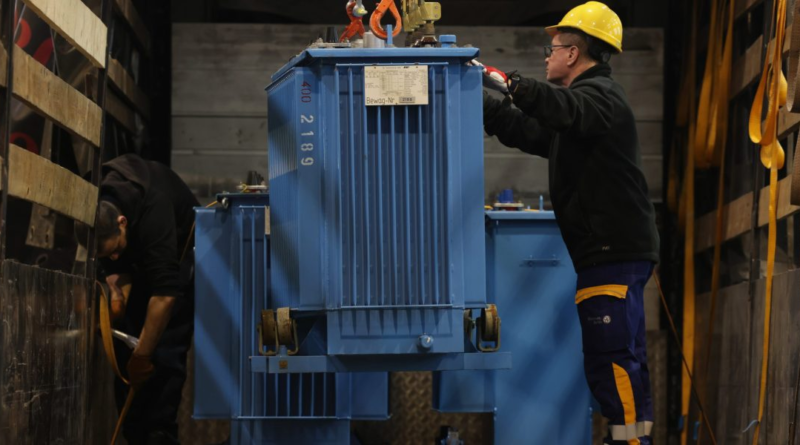Electrical transformers are the giant bottleneck waiting for the AI industry: ‘It’s going to take several years’
But for all the futuristic problems AI promises to solve, there’s a distinctly practical one that’s threatening to hold it back from scaling up en masse. AI data centers rely on specialized electrical transformers—refrigerator-size units that convert current to a safe voltage—to integrate with the grid, the network of power plants and wires that carry electricity across the country. But those transformers are in extremely short supply right now—so much so that wait times for new units are as high as four years. Demand has also sent prices up some 70% since January 2020. The supply-chain pressures and historical trends that have caused the shortage aren’t showing signs of easing.
“Unless we do see considerable investment—both at the commodity level and in manufacturing of transformers—I think the shortage that we’re currently in is only going to continue to get worse,” Benjamin Boucher, energy analyst at consultancy Wood Mackenzie, tells Fortune. “It’s going to take several years to actually get a lot of that [AI] capacity online.”
Years of underinvestment and consolidation in this niche manufacturing sector have caused a transformer bottleneck that’s colliding with a boom in demand from the AI and renewable energy sectors. Analysts’ only hope is that innovation—or maybe even engineering help from AI itself—will yield another way to power data centers without having to wait years for new transformer capacity.
“AI presents what I describe as ‘self-raising bootstraps,’ in that AI will … help with balancing [electrical] loads,” Edward Wilford, a semiconductor analyst at consultancy Omdia, tells Fortune. “With short notice, there’s always going to be a shortage of some kind. So you throw the dice, and you just assume that the industry you’ve built up will be enough to carry you through.”
Clearly, this could have huge ramifications for the stock market, riding at all-time highs after blowout appreciation, especially for the nearly $2 trillion Nvidia. This analyst, however, said that was just far too early to call, while many other analysts and market watchers are feverishly debating whether the market is approaching bubble levels.
What is a transformer, and why is it critical to AI development?
Transformers are essential devices for electrical projects that are connected to the grid. In order to effectively transmit power across hundreds of miles, transformers are needed to “step up” voltage to a higher level on the transmitting end, says Boucher. But that high-voltage current isn’t safe for use in homes, offices, or data centers, so “step-down” transformers are installed on the receiving end to bring the voltage back down to usable levels. These transformers are bulky, expensive units that often look like large chest freezers. They’re irreplaceable for safety reasons: Using voltage that’s too high can be deadly or fry expensive electrical components, so most insurance companies and utilities require a full backup set for critical projects.
Since 2020, there’s been a massive surge in demand for both types of transformers. AI startups and data centers desperately need step-down transformers to be able to plug into the grid and access electrical power. And solar and wind farms need step-up transformers to be able to transmit the power they’re generating to consumers.
“We’ve just seen such a huge boom in demand for transformers recently,” Boucher says. “It’s all become a perfect storm for transformers in the sense that there’s just so much demand right now, and the supply just hasn’t been able to cope with it.”
Transformer supply struggles go way back
The reasons for lagging transformer supply go back much further than the pandemic. As early as the 1980s, American transformer manufacturers began consolidating, and the industry continued to contract after its boom years of the ’60s and ’70s when most of the electrical grid was built. Those cuts mean that today, domestic manufacturers can only supply about 20% of American transformer demand. (Imports make up the difference—China and Mexico are the two biggest suppliers.)
Soaring raw-material and labor costs have also hurt production. Commodities prices for the copper and specialized electrical steel needed to produce transformers have doubled since 2020. (There’s only one company in the United States, AK Steel, that manufactures electrical steel.)
Historical precedent makes transformer manufacturers hesitant to scale up production too quickly. The same companies went into overdrive to meet rising electrical demand during the pre-2008 housing boom, but lost big when the market crashed. Transformer manufacturers are also looking at the semiconductor industry, which experienced a bullwhip effect of its own a few years ago: Buyers were desperate for more chips as supply chains slowed down, but by the time manufacturers had invested millions in boosting production, demand had dried up. Transformer manufacturers must be certain that demand for AI and renewables is here to stay before investing in new production.
“One thing we’ve learned in the industry from the supply-chain issues in semiconductors is that there will be no rush to make up a shortage if that will result in an oversupply,” Wilford says. “No one wants to go build infrastructure where you need 10 years to pay it off, and then suddenly have it be [worth nothing] because you built too much.”
Solutions that don’t exist yet
Recognizing that a bump in demand could overwhelm domestic transformer manufacturers, the Biden administration signed executive orders in June 2022 allocating aid for the industry through the Defense Production Act—but nothing’s come of that yet, and the transformer industry didn’t get any funding in the $1.7 trillion 2022 Omnibus Appropriations Bill. International suppliers have also struggled to catch up.
“We need more investment in terms of manufacturing and transformers, especially domestically,” Boucher says. “I think the supply chain needs to be really shored up to be able to account for more than 20% of demand.”
AI is expanding so fast that if any relief is going to make a difference, it has to come quickly. Worldwide spending on data centers and the other hardware behind AI development is expected to surpass $4 billion by 2030.
“When you factor in all of the additional power that’s going to be needed to go into AI and data centers, I could definitely see it creating an even bigger void as it comes to transformer supply,” Boucher says. “It could definitely put the transformer industry in a bigger hole than we’re already in.”
If the industry can find another way to power data centers, though, a transformer shortage will be a moot point. Analysts hope that innovation will be the solution—even though the question of exactly how else to provide power hasn’t yet been answered.
“I’m not worried about it hampering the industry because I think we will find solutions,” Wilford says. ”We’ll wait for the market to take care of this—the companies themselves will find ways. They’re looking at putting small nuclear reactors in [data centers].”
Alternative proposals have included building AI data centers in the desert surrounded by solar panels, and using AI to more efficiently regulate power usage and integrate data centers into the existing grid. Wilford pointed to Taiwanese semiconductor giant TSMC, which solved its own electrical demands by simply leasing an offshore wind farm in 2020 and generating its power in-house, rather than sourcing it from the grid.
“People will keep finding solutions,” Wilford says. “I hope they’re good ones.”




